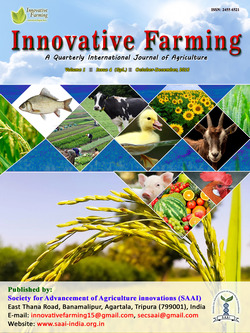
Survey and Documentation of Natural Enemies of Maruca vitrata (Geyer) in Pulse Growing Areas of Coimbatore and Pudukkottai Districts
Haripriya, K.*
Department of Agricultural Entomology, Tamil Nadu Agricultural University, Coimbatore- 3, INDIA
S. Jeyarani
Department of Agricultural Entomology, Tamil Nadu Agricultural University, Coimbatore- 3, INDIA
DOI: NIL
Keywords: Maruca vitrata, Survey, Natural enemies, Braconids, Ichneumonids.
Abstract
An extensive survey was made at different pulse growing blocks of Coimbatore District viz., Annur, Karamadai, Madhukkarai, Periyanayakkanpalayam, Pollachi, Sulur, Thondamuthur, Tamil Nadu Agricultural University (TNAU) - Orchard and Pudukkottai District viz., Arantangi, Gandarvakottai, Karambakudi, Thirumayam, Thiruvarankulam and National Pulses Research Centre (NPRC), Vamban on the incidence of natural enemies of Maruca vitrata. Survey revealed that the level of parasitism of legume pod borer under field conditions ranged from 0.00 to 30.00 per cent. Highest parasitization of 30.00 per cent was recorded in National Pulses Research Centre, Vamban. Ponnaviduthi village of Karambakudi block in Pudukkottai district recorded the second highest parasitization of 20.00 per cent followed by Irumborai village of Karamadai block in Coimbatore district. During the survey, four larval parasitoids belonging to the families viz., Braconidae and Ichneumonidae were recorded. The braconid parasitoids that were recorded include Bassus sp. and Phanerotoma sp.
Downloads
not found
Reference
Arodokoun, D.Y., M. Tamo, C. Cloutier and J. Brodeur. 2006. Larval parasitoids occurring on Maruca vitrata Fabricius (Lepidoptera: Pyralidae) in Benin, West Africa. Agric. Ecosystem Environ., 113: 320–325.
Barrion, A.T., J.P. Bandong, C.G. De La Cruz, R.F. Apostol and J.A. Litsinger. 1987. Natural enemies of the bean pod-borer, Maruca testulalis in the Philippines. Trop. Grain Legume Bull., 34: 21-22.
Owuor, O., O.J.B., Owuor, G.W. Oloo and P.O. Agwaro. 1991. Natural enemies of the legume pod borer, Maruca testulalis Geyer (Lepidoptera: Pyralidae) in small scale farming systems of western Kenya. Insect Sci. Appl., 12: 35-42.
Pillai. A.K and M. Agnihotri. 2013. Biology and Predatory Potential of Eocanthecona furcellata (Wolff.) on Maruca vitrata Geyer. Madras Agric. J., 100 (1-3): 193-195.
Rabindra, R.J., C.R. Ballali and B. Ramanujan. 2004. Biological options for insect pests and nematode management in pulses. In: Ali, M., B.B. Singh, S. Kumar and V. Dhar. (eds), Pulses in New Prespective. Indian Society of Pulses Research and Development, Kanpur, India. Pp. 400-425.
Rekha, S. and C.P. Mallapur. 2007. Studies on insect pests of Dolichos bean in Northern Karnataka. Karnataka J. Agric. Sci., 20(2): 407-409.
Saxena, H.P. 1978. Pests of grain legumes and their control in India. In: S.R. Singh, H.F. van Emden and T.A. Taylor (eds), Pests of grain legumes: ecology and control. Academic Press, London, U.K. Pp. 15–23.
Sharma, H.C. 1998. Bionomics, host plant resistance and management of the legume pod borer, Maruca vitrata - a review. Crop Prot., 17: 373-386.
Singh, A.K. and S. Kumar. 2003. Effect of meteorological parameters on population buildup of defoliations on cowpea. Annals of Plant Protection Sciences, 11(1): 156-158.
Singh, S.R. and D.J. Allen. 1980. Pests, diseases, resistance and protection of Vigna unguiculata (L.) Walp. In: Summerfield R.J. and A.H. Bunting. (eds), Advances in Legume Science. London Royal Botanic Garden, Kew and Ministry of Agriculture, Fisheries and Food, London, Pp.419-433.
Srinivasan, R., S. Yule, M.Y. Lin and C. Khumsuwan. 2015. Recent developments in the biological control of legume pod borer (Maruca vitrata) on yard-long bean. Legume Res., 38(5): 687-690.
Usua, E.J. and S.P. Singh. 1977. Parasites and predators of the cowpea pod-borer, Maruca testulalis (Lepidoptera: Pyralidae). Nigerian J. Entomol., 1: 100-102.
Wetro, E., A.K. Tounou, C. Agboton, B. Datinon, E. Dannon, R. Srinivasan and M. Tamo. 2014. Bionomics of the parasitoid Apanteles taragamae as influenced by different diets fed to its host, Maruca vitrata. BioControl, 59(1): 55-65.
